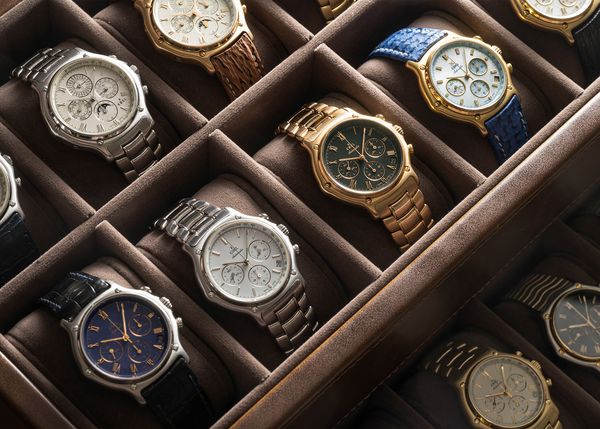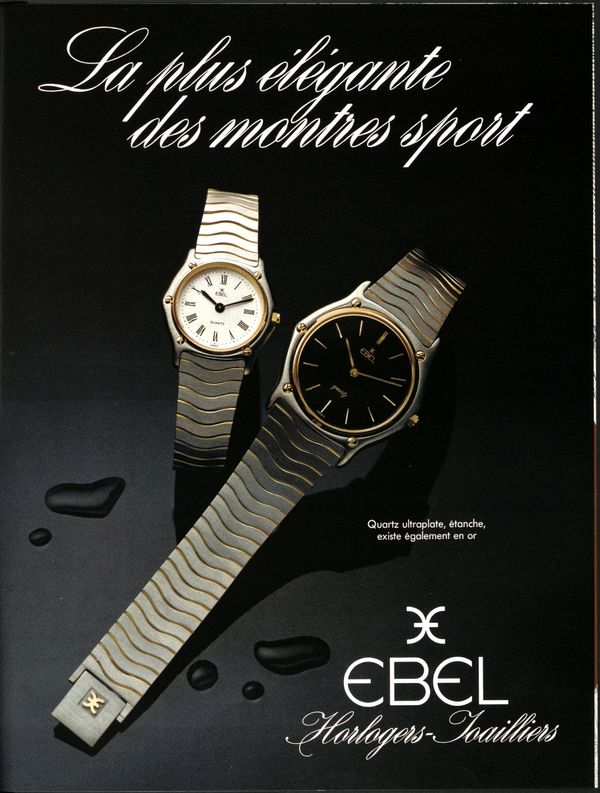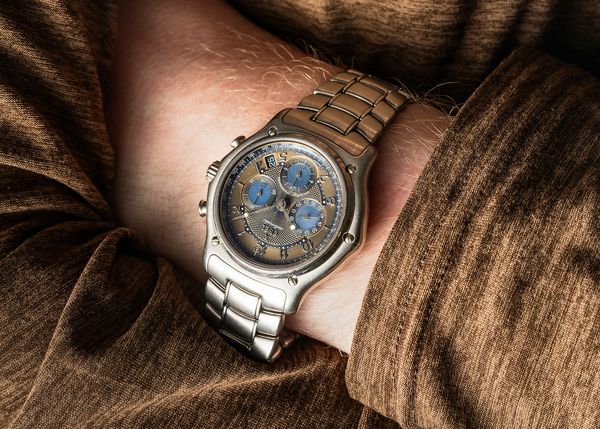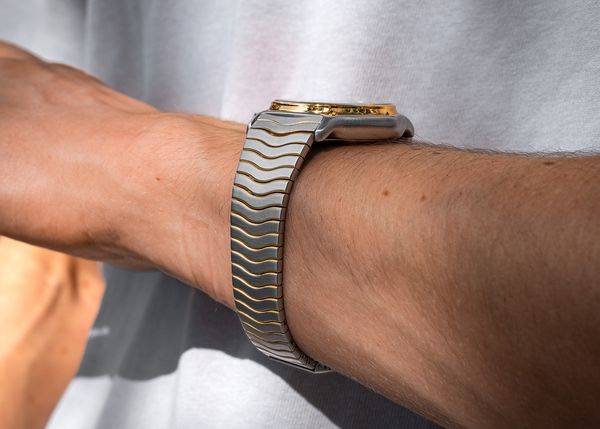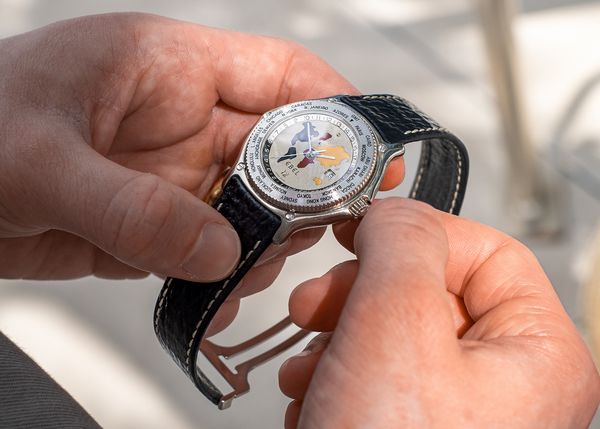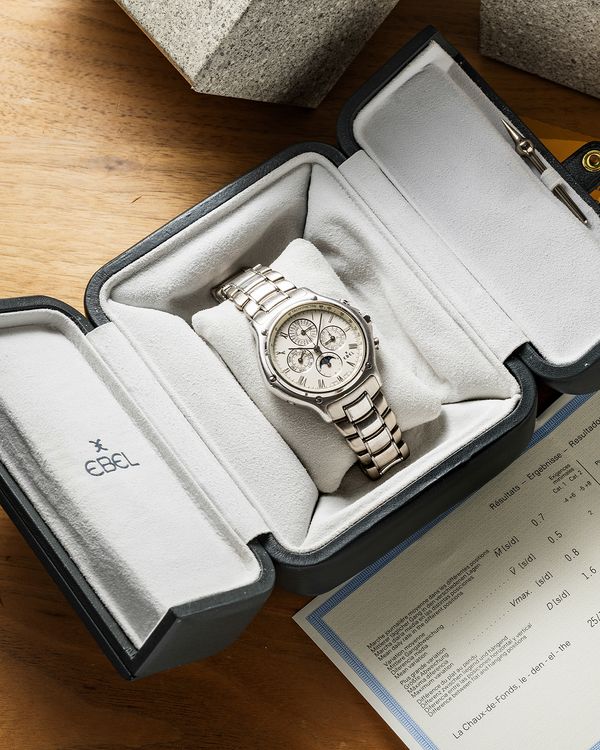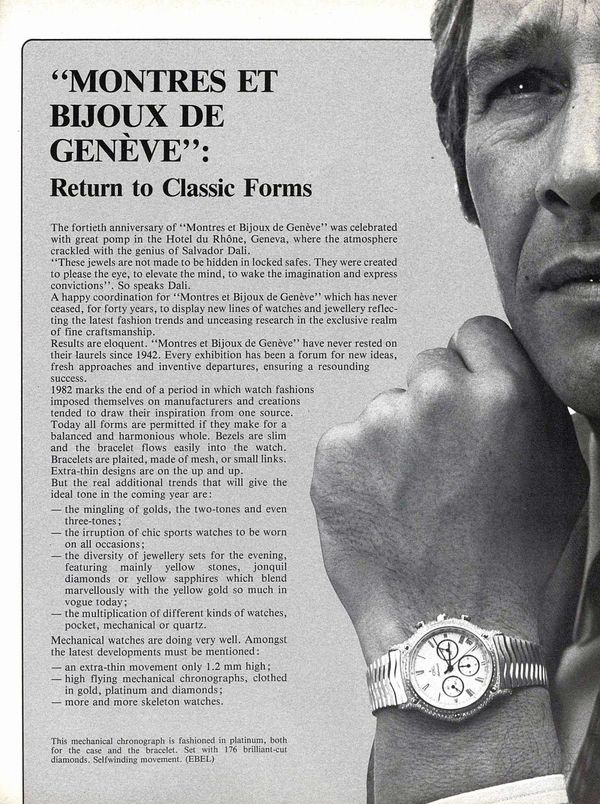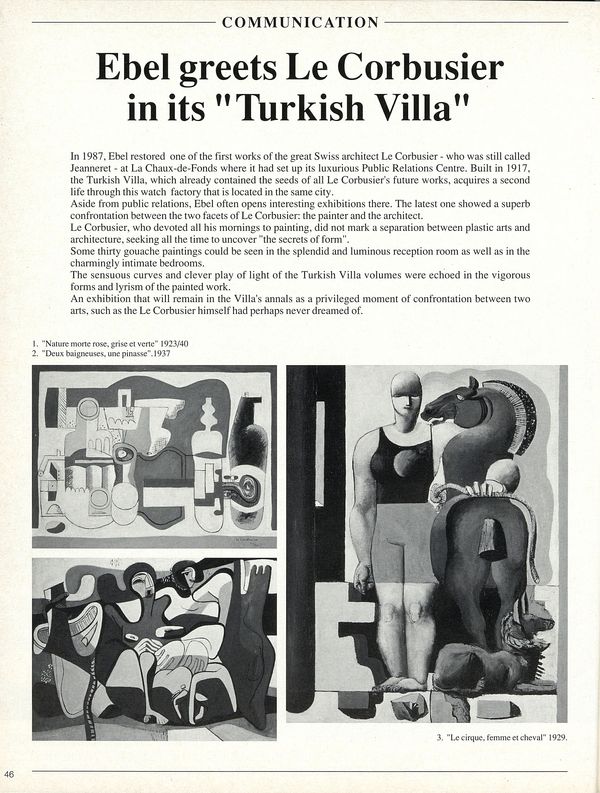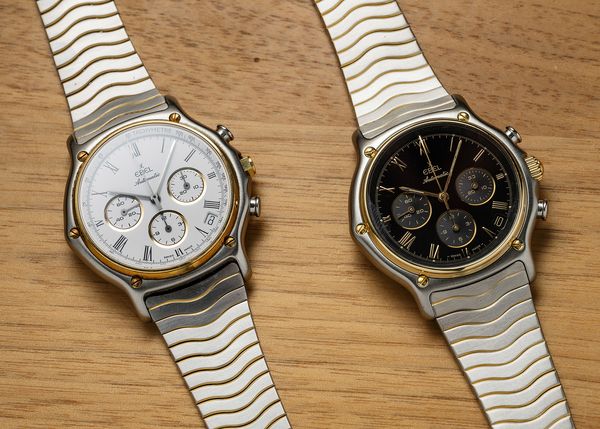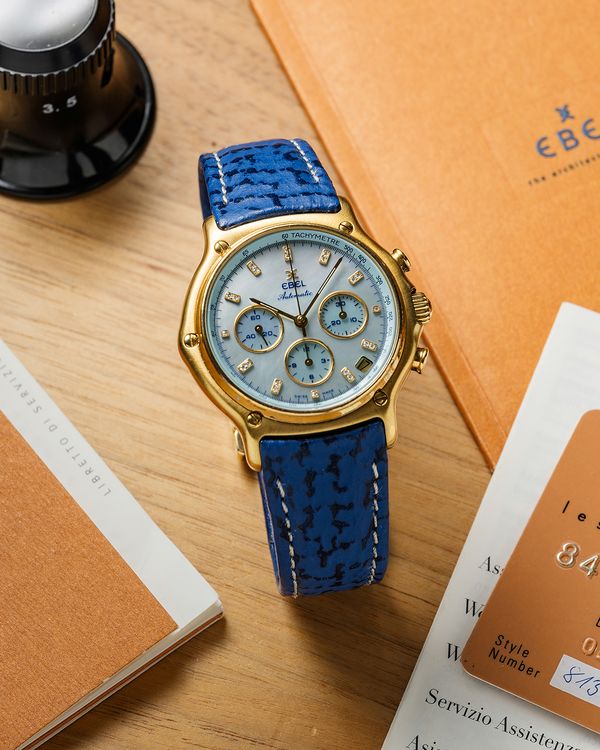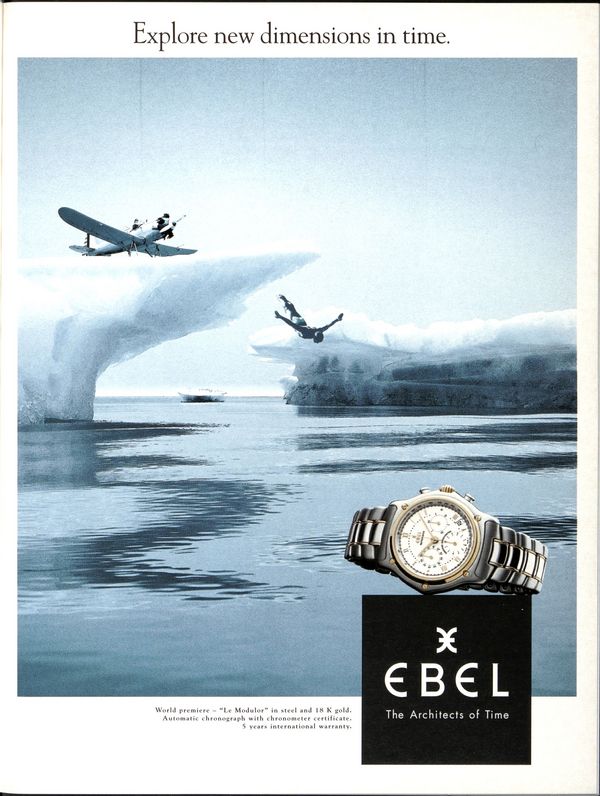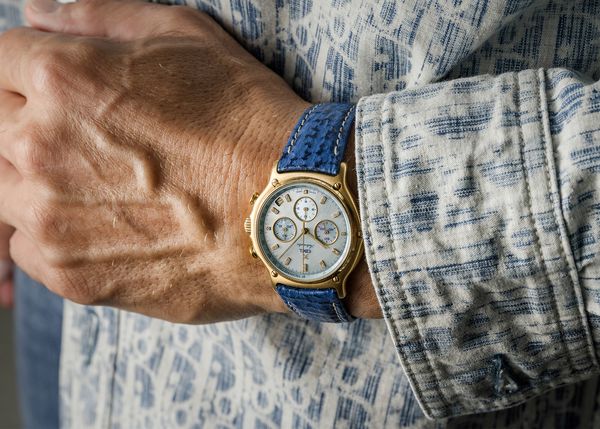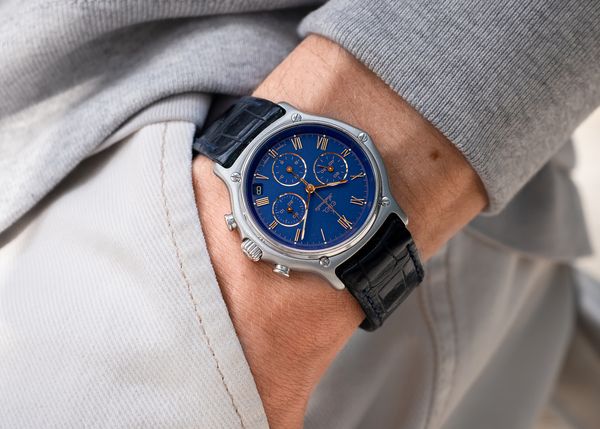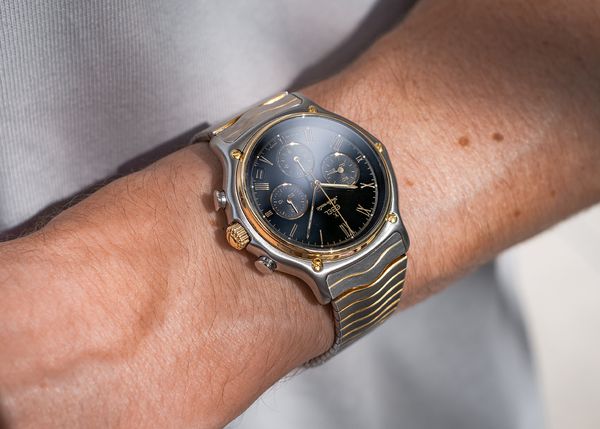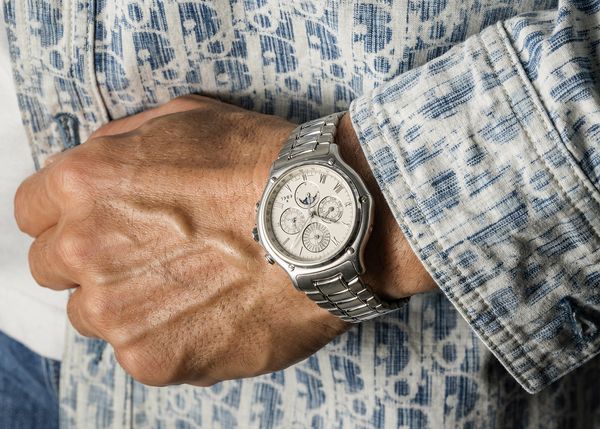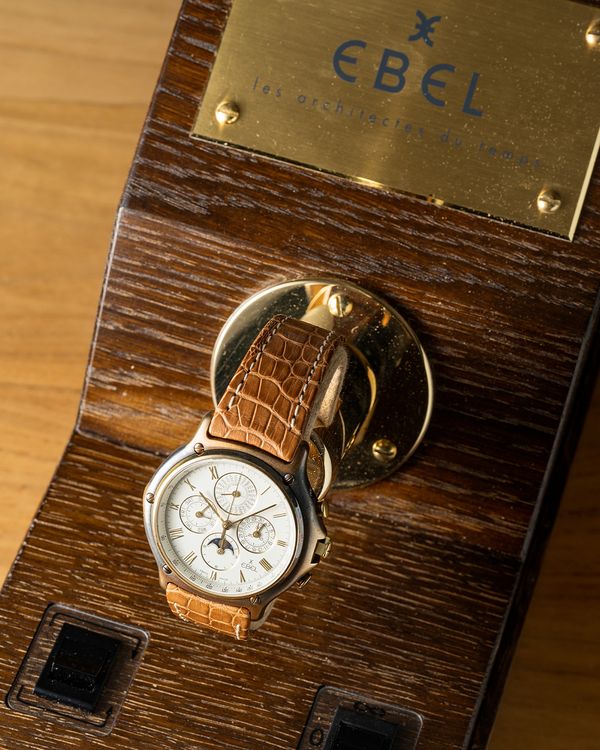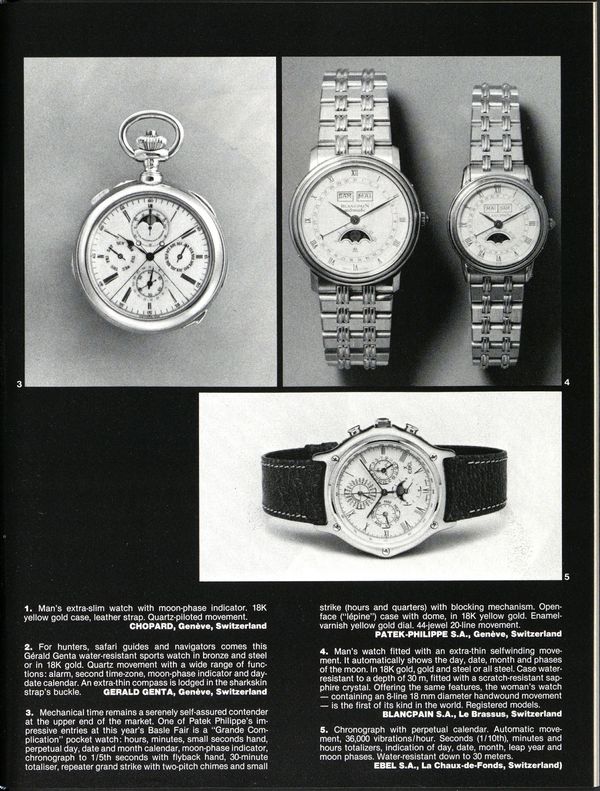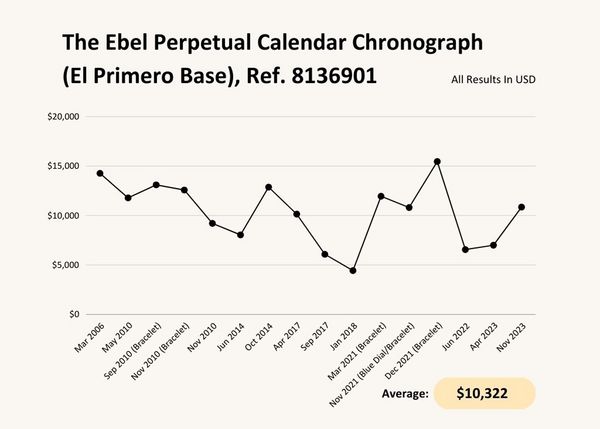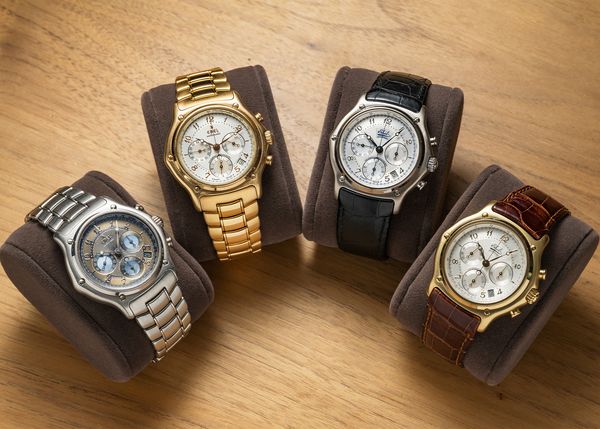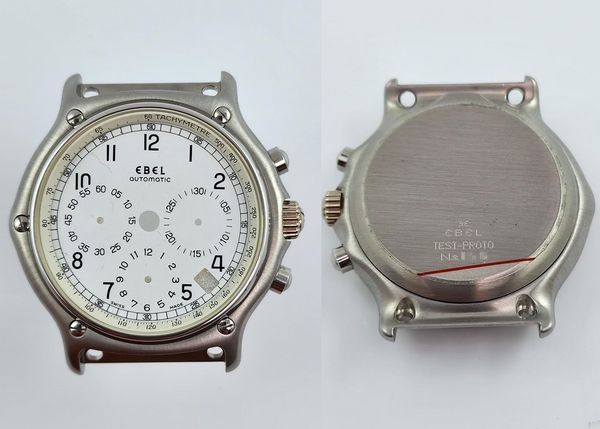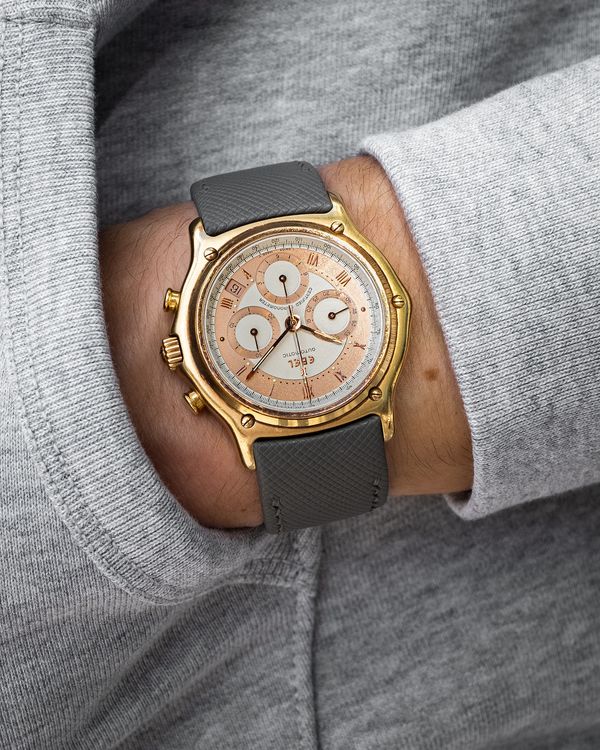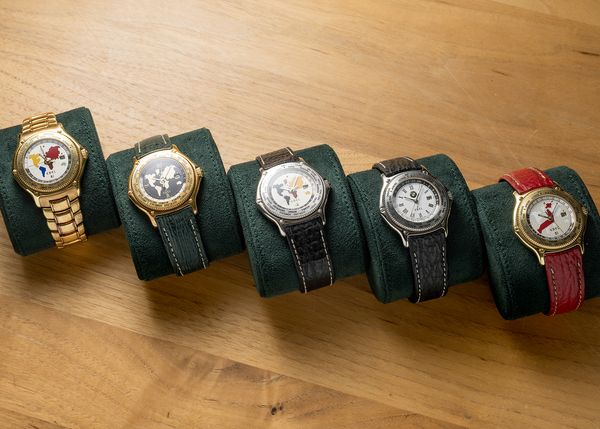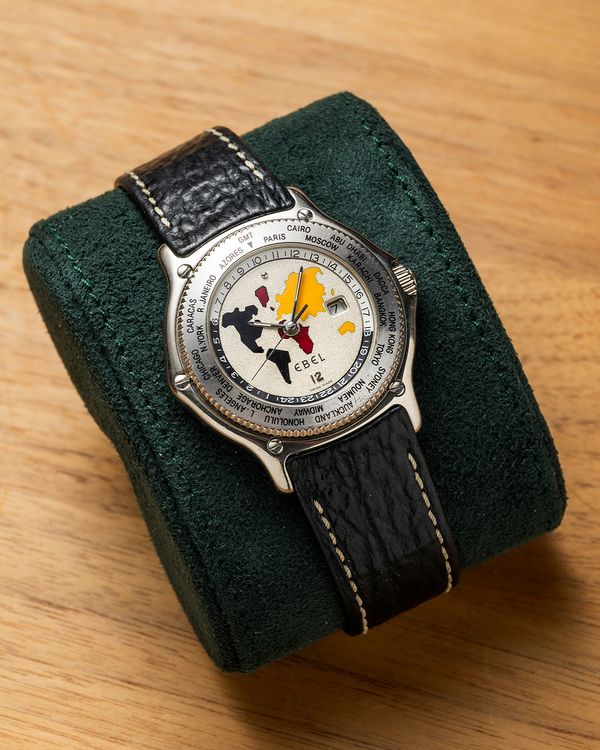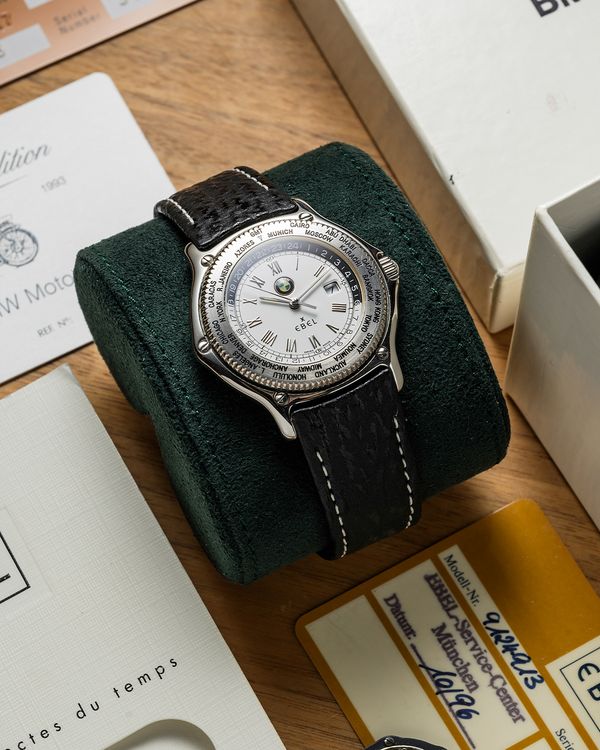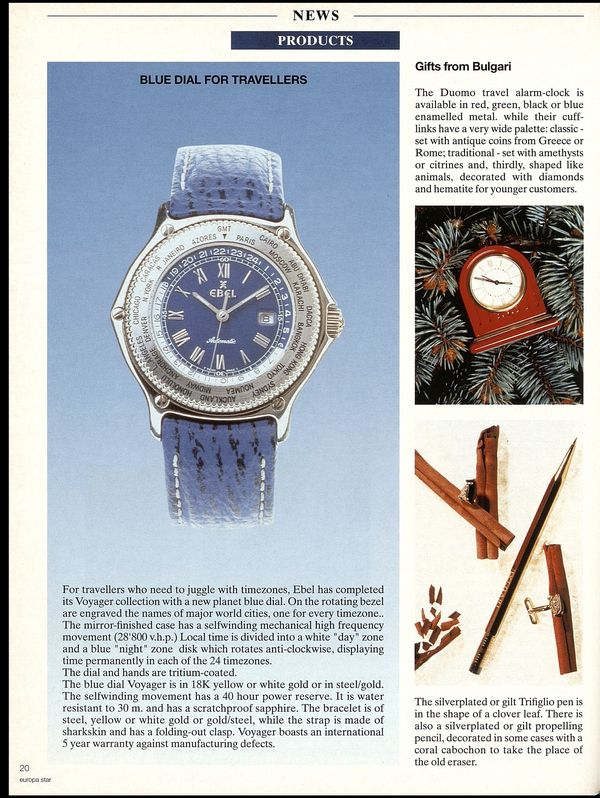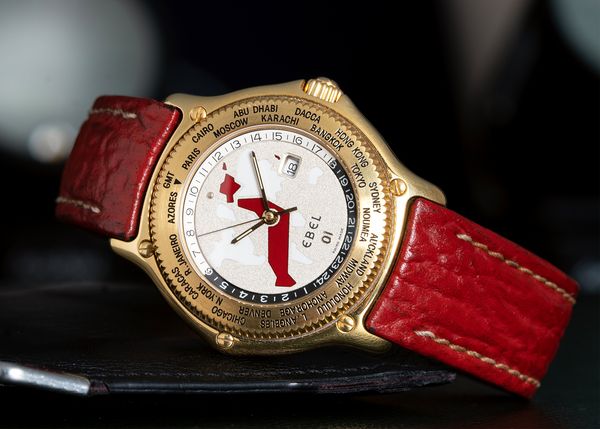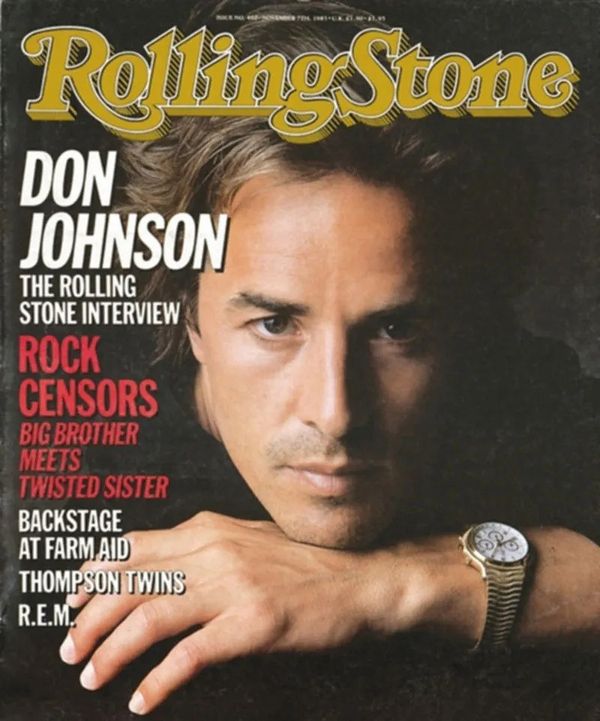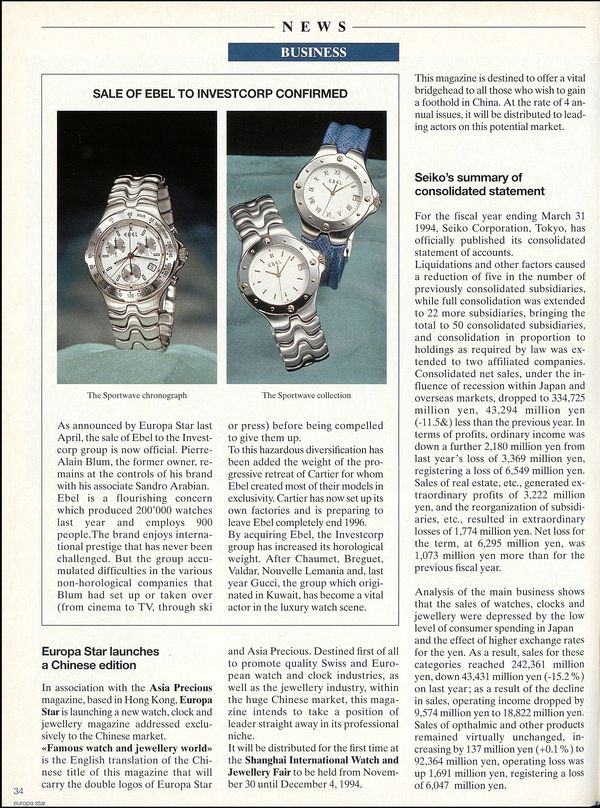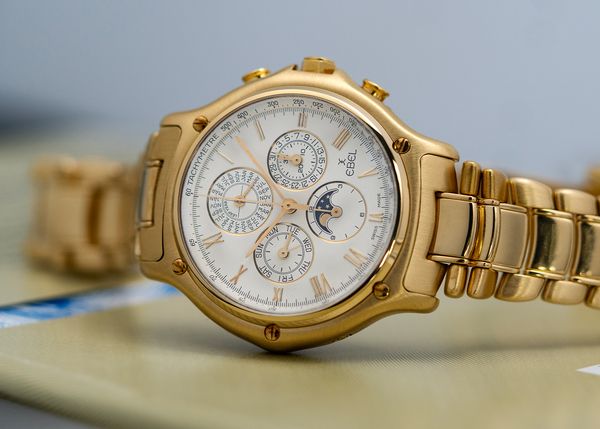Welcome to The Fine Print, our in-depth column dedicated to shining a light on the many hidden, forgotten corners of the watch collecting hobby. Today we're focusing on an unusual group of neo-vintage watches from a Swiss brand that deserves so much more respect and attention than it's received in the recent past.
– Text by Logan Baker; Images by James K/ @waitlisted (unless noted)
Editor's Note: The following article was published in January 2024, and at the time of its publication, none of the watches were for sale. However, a few of the watches are now being offered during the Phillips Reloaded: The Rebirth of Mechanical Watchmaking, 1980-1999 thematic auction, on November 8, 2024. To learn more about these pieces, please visit the online catalog to review the footnotes dedicated to each watch.
Pierre-Alain Blum is a name you should know.
It wasn't long ago that he was mentioned in the same breath as men like Jean-Claude Biver and Nicolas Hayek as the most successful and influential Swiss watch executives of the late 20th century.
But Blum didn't get there by working at, or running, a massive conglomerate. He did it at his family's business, as the third-generation leader of Ebel, a La Chaux-de-Fonds watch company founded by his grandparents in 1911. After taking the reins of the company over from his father in the early 1970s, Blum's innovative leadership elevated Ebel to new heights, despite deaing with the formidable industry downturn caused by the Quartz Revolution. Believe it or not, but Ebel was a household name around the world by the beginning of the 1980s – all because of Blum.
I won't blame you, however, for potentially being unaware of Blum and his legacy – because, be honest, when was the last time you (or anyone you know) actually thought about Ebel? If your watch collecting journey didn’t begin prior to the turn of the century, the answer might legitimately be never.
I know my interest in, and overall awareness of, Ebel was more or less limited to recognizing its historic use of El Primero chronograph movements, as well as its appearance on and sponsorship of Miami Vice.
Oh, and I could recognize some of the watches, too – it's hard to miss Ebel's indulgent approach to case and bracelet design.
What I was absolutely unaware of, though, was just how culturally significant Ebel came to be between the late 1970s and mid-1990s. The Swiss watchmaker’s creations in this period, all under the direction of Blum, captivated an entire generation in a way that simply hasn't happened since. Those "overwhelming" designs I mentioned? Well, they were a perfect fit for the era, seamlessly blending in with the retro-futurism trend that took over 1980s fashion and culture.
Ebel's organic, flowing cases looked unlike any watch on the market – even today, there's no mistaking an '80s or '90s Ebel for anything else. Ebel's watches in this period were also unexpectedly lavish, almost aggressively so, during an era that for most of the Swiss watch industry could at best be characterized as "lean."
Today’s collectors that grew up seeing Ebel watches on the covers of magazines and on the wrists of celebrities are now established enough to go out and hunt down those dream watches from their youth.
Robert-Jan Broer, founder of the Fratello Watches media platform, did exactly that late last year, eventually penning a well-written article on his experience of finally owning a watch he had pined over for decades. Ben Dunn, of Watch Brothers London, a UK-based boutique focused on neo-vintage timepieces, published a detailed guide on collecting El Primero-powered Ebel chronographs in August of last year.
Perhaps sensing some momentum building in the brand’s direction, Ebel – the current-day company – announced an official reissue of its legendary 1911 Chronograph at the very end of 2023.
I’ve been paying close attention to all these developments for a reason.
Last April, I flew down to Miami with a photographer friend (@waitlisted) for a visit with Alfredo Paramico, one of the watch world’s most prominent collectors, and a close friend of Phillips in Association with Bacs & Russo, to discover his growing collection of neo-vintage Ebel timepieces.
Well-known for his love of vintage Patek Philippe and collectibles of all types – you might remember the time Arthur Touchot chronicled his impressive Royal Oak Offshore collection – Paramico fell down the Ebel rabbit hole a few years ago as a way to fulfill a childhood fascination with the brand. He quicky put together an impressive collection of more than 30 neo-vintage Ebel wristwatches, of varying complexity and rarity, which he generously allowed us to spend some time with and photograph. The watches all came from Ebel’s four core collections of the 1980s and ‘90s: the Sport Classic Chronograph/1911 Chronograph, the Perpetual Calendar Chronograph, the Le Modulor Chronograph, and the Voyager.
These four collections were emblematic of Ebel’s historic peak, Paramico explained to us. They're from a period when Ebel was the hottest, most innovative watchmaker in Switzerland, capable of standing toe-to-toe with the industry's giants.
Today these watches offer tremendous value to collectors. The prices they've traded hands for in recent years don't represent the quality of the high-grade, complicated mechanical movements inside, nor the remarkable complexity of Ebel's case and bracelet constructions.
Interest in these pieces has seen a steady decline for at least two decades now (if not longer), and while there are a few savvy collectors and dealers that are just now beginning to wake up to this one-time giant of Swiss watchmaking, there’s still a long way to go until Ebel enjoys a level of recognition anywhere close to what it once had.
I've spent the past few months researching Ebel, its history, and the significance of the watches in Paramico's collection, in order to better understand this remarkable period in watchmaking history. And thanks to Paramico’s deep passion for these watches, I believe we’ve been able to create the most detailed guide yet on the four of most collectible Ebel wristwatches.
The Swiss Watch Industry's Great '80s Success Story
Ebel was founded in 1911 by Eugène Blum and his wife, Alice (née Lévy), and it remained a family business until the end of the 20th century. However, the exact era we’ll focus on today begins in 1977, when Eugene and Alice's grandson, Pierre-Alain, finally revealed a project he'd worked on for years: the quartz-powered Sport Classic collection of wristwatches.
The Swiss watch world was facing an existential crisis at the time, a result of the swiftly growing international popularity of affordable quartz-powered timepieces produced in Japan. Switzerland, with its more traditional approach to watch manufacturing, was losing market share by the day.
The Swiss weren't helpless during this period. Swiss watchmaking businesses of all types and sizes were working together in an attempt to bring their own "Swiss Made" quartz wristwatches to market. Under Blum’s leadership, Ebel was able to quickly assume a position as an industry leader in the category.
Blum even teamed up with another up-and-coming executive in the business, a promising young Cartier manager named Alain-Dominique Perrin.
Perrin's stroke of brilliance came when he dreamed up the Must de Cartier collection, a more affordable line of products that could bring in new customers while capitalizing off Cartier's design excellence and name recognition. The result? Massive profits for Cartier, which subsequently elevated Perrin's profile, allowing him to work with the wealthy South African businessman Johann Rupert (who would go on to found Richemont) to put together enough funds to create Cartier International, reuniting the three separate Cartier branches in New York, London, and Paris.
What does that have to do with Blum and Ebel? Plenty. The friendly relationship between Perrin and Blum turned into a 1972 contract granting Ebel production rights to a new range of Swiss-made quartz watches under the Cartier brand, including the emergent Must de Cartier collection.
The booming success of this partnership provided Perrin with the funds to make the changes he sought at Cartier, and Blum with the confidence to buy out his father, Charles, from the family business, in 1975. It also provided Ebel with enough financial latitude to start experimenting with new, fashion-forward watch designs to appeal to younger generations. (Cartier and Ebel would eventually establish a more formal manufacturing venture together, in the early 1990s, called Compagnie Ebel Cartier, or CEC, to produce watch cases, dials, and quartz movements.)
The result of Ebel's creative experiments eventually arrived in 1977, with the debut of the Sport Classic collection. These were the first watches produced in the recognizable sporty-chic style that defined Ebel's aesthetic codes through the following decades. The Sport Classic models introduced familiar elements, such as Ebel's now-iconic “wave”-style bracelet, a bezel with five screws, as well as a totally smooth, hexagonal case design with no angles or harsh lines at all, only curves. It was unlike anything else on the consumer market at the time.
Ebel didn't try to mimic something popular, they did things their own way.
The seamless integration of the lightweight, thin case with the perfect flow of Ebel's "wave" bracelet also represents somewhat of a forgotten trend-setting moment in Swiss watchmaking. This was two years before Audemars Piguet brought out the famously integrated Royal Oak, mind you.
While most of the rest of the Swiss industry was struggling, Ebel was more profitable than ever before. Blum wasn't satisfied yet.
He was soon so emboldened by his success in the 1970s that he decided the new decade would come with a significant pivot in Ebel's business model, one that would see the company lean further than ever into the realm of high-end "luxury" watchmaking.
Blum made the decision that Ebel would come out with an all-new mechanical chronograph, a watch that could serve as a true halo product for his growing business.
Ebel had neither the mechanical capacity or capability that was needed to develop a brand-new chronograph movement from scratch at the time. So they inquired with a Vallée de Joux neighbor, Zenith, on whether or not the brand’s high-beat automatic chronograph caliber from 1969, El Primero, could potentially serve as the mechanical base, an ébauche, inside Ebel’s new chronograph.
It's a well-known story – Zenith had ceased production of all mechanical movements in the mid-1970s, while briefly under the ownership of the U.S.-based Zenith Radio Company. As a result, the few employees still working for Zenith in Switzerland by the time the '80s rolled around was minuscule. They had no clue whether or not any existing El Primero ébauches or blanks could be sold, or even if the necessary tooling still existed that could be used to reproduce them.
Enter Charles Vermot, a senior engineer within Zenith’s ébauche department.
Vermot was so passionate about his work at Zenith, in particular his role in developing El Primero, that he took it upon himself to hide thousands of El Primero ébauches, as well as all the necessary tooling required to make the movements, inside an attic at Zenith’s longtime headquarters in Le Locle, after the company had shut its doors seemingly for good in the mid/late 1970s.
Once Vermot revealed those details to what was left of Zenith’s management, they quickly approved the sale of the remaining El Primero ébauches to Ebel beginning in 1981, who would famously be joined in sourcing El Primeros by Rolex in 1988 (of course, Rolex lowered the El Primero's beat rate down to 4 Hz – one major difference). Although Rolex is often credited for spearheading Zenith's modern revival due to the use of El Primero movements inside the Cosmograph Daytona, it was clearly Ebel that enabled Zenith to start fresh.
Ebel's Sport Classic Chronograph was officially introduced shortly thereafter, in 1982, with an El Primero ticking away inside the watch at 5 Hz. The only difference? It was now known as the Ebel caliber 134.
The original Sport Classic Chronograph had a 38mm × 11mm case profile, while continuing to utilize Ebel's same "extravagant" design philosophy introduced in 1977. The "wave" bracelet was there, and so were the five screws set on the watch's bezel.
The exact El Primero calibers used in the early Sport Classic Chronographs were likely new-old-stock examples of El Primero caliber 3019PHC that had been produced in the 1970s and were never used before being hidden by Vermot.
In 1986, Ebel celebrated its 75th anniversary with the introduction of an entirely new collection, dubbed “1911” after the company’s foundational year. The 1911 Chronograph models were outfitted with a new "link"-style bracelet that officially replaced the "wave" bracelet and had first appeared the prior year, when Ebel announced its Discovery dive watch platform. The link bracelets are now considered to be just as iconic as the original wave bracelets were. It was likely the design of these link bracelet bracelets that influenced TAG Heuer’s S/el, Link, and Kirium collections.
I'll say it again – Ebel was leagues ahead of the rest of the watch world when it came to complex bracelet construction.
"These are the best bracelets ever produced," Paramico says. "They're soft, they're comfy, and they perfectly adhere to the wrist. A true gem! It's no surprise they used to cost a lot, and when I say a lot, I mean they were tremendously expensive! I have a watch that came with two invoices. One was for the watch, the other for the bracelet. The cost of the bracelet was nearly 150 percent of the price of the watch! That's why it can be quite difficult to find Ebel's bracelets today and virtually impossible for white gold and platinum watches."
The movements inside the 1911 Chronographs also changed. They were now marked as the updated El Primero caliber 40.0/400 rather than the 3019PHC. The caliber 40.0 was a transitional El Primero produced solely in 1986, while Zenith's team got back up to speed; the caliber 400 officially joined the show in 1987.
Funnily enough, a similar transition was also happening with Ebel on the small screen.
When Miami Vice debuted on NBC in 1984, star Don Johnson, playing lead “Sonny” Crockett, wore what's believed to be a reproduction of a Rolex Day-Date on his wrist, due to the show’s limited initial budget. However, once it was clear Miami Vice would be a massive hit, Crockett upgraded to an Ebel.
Blum sponsored the show and worked with Miami Vice’s producers to ensure Ebel would have a starring role in the series. Johnson initially wore an example of a Sport Classic Chronograph with the wave bracelet during the second season of the show, before it was replaced by Ebel's updated 1911 Chronograph starting from the third season to the final one.
It was the mid-1980s, and Ebel and Blum were on top of the world.
Ebel's watches were 100-percent Swiss made, regardless of the use of quartz or mechanical movements, and Blum was leading more than 500 employees across five different facilities in La Chaux-de-Fonds. It must have felt like Ebel was suddenly everywhere. Legendary golfer Greg Norman wore an Ebel while winning the 1986 British Open. Tennis stars Boris Becker and Stefan Edberg both wore Ebel watches while winning Wimbledon, at different points that decade. Formula 1 drivers Alain Prost and Niki Lauda could also be spotted wearing various Ebels over the years.
Ebel even acquired a Le Corbusier-designed property in 1986, known as "Villa Turque," in La Chaux-de-Fonds, in order to emphasize its slogan at the time: "Ebel – The Architects of Time."
Ebel still owns the building to this day.
Collecting The El Primero-Powered Ebel Sport Classic And 1911 Chronographs
Before moving on to Ebel's other three important collections, let’s dig a little deeper into what you'll need to know if you’re now interested in finding a neo-vintage El Primero-powered Ebel chronograph for yourself.
Ebel used a relatively simple system to generate reference numbers in this era that's extremely helpful to understand. The company used the same exact numeric system for the Sport Classic/1911 Chronographs, the Le Modulor Chronographs, and the Perpetual Calendar Chronographs.
The backs of these watches will all have different markings, but you should pay close attention to the seven-digit code placed at the very bottom of each caseback. The first number represents the watch's specific case metal, while the middle three digits indicate the movement, and the final three numbers can be tied to both the diameter of the watch and the type of caseback (solid or exhibition).
The corresponding numbers are broken down below.
Case Metal:
8 = yellow gold
5 = rose gold
3 = white gold
4 = platinum (special order only)
9 = steel
1 = steel and gold
Movement Base:
134 = El Primero ébauche
137 = Lemania ébauche
Case Design:
901 = 38mm, El Primero, closed caseback
240 = 40mm, Le Modulor, exhibition caseback
241 = 40mm, Le Modulor, closed caseback
An 18k yellow gold El Primero-based Sport Classic Chronograph, for example, would be represented by “8134901."
I'll make a note here that Ben Dunn of Watch Brothers London did identify an extended form reference number originally assigned by Ebel for each watch, in his guide to these chronographs from last year. These extensions are simply another four digits added to the seven primary ones discussed above – two of those digits are used to identify the watch's specific dial/strap configuration, while the other two can be used to determine the exact style of dial. These extra-long reference numbers will typically only be found in an Ebel catalog or product brochure.
Additionally, every watch has a unique serial number that's also found on the caseback. The serial numbers of all three of Ebel's mechanical chronographs from this period (El Primero base, El Primero base with QP module, and Le Modulor) begin with “64” followed by a pair of digits that indicate the watch's exact case metal (10, yellow gold; 20, rose gold; 30, white gold; 70, platinum; 50, steel; 61, steel and gold). The final four digits are the only ones that are unique to each watch; they represent every watch’s specific production number.
Paramico pointed out to me that the decision to utilize only four digits here indicates that the total production number of every individual movement/material configuration likely has to be limited to no more than 9,999 total examples each (although it’s far more likely that most mechanical Ebel wristwatches from this era were produced in far smaller numbers than that).
One interesting variable when it comes to these chronographs is that Ebel seems to have created them in an almost endless series of dial configurations. The above picture features a blue mother-of-pearl dial example with diamond hour markers (left), with another that has a dial crafted from pure obsidian with diamond hour markers, not to mention its solid 18k yellow gold case and bracelet (center).
Dials came in multiple shades of white, off-white/cream, and grey. They came in solid black, or a riveting shade of cobalt blue. Hour markers could be basic printed Roman numerals in black, or they could be gilt Roman numerals applied to the dial ot give the whole presentation a more three-dimensional affair. And don't forget the diamond hour markers! They're rare to find but still pop up for sale on occasion.
It feels important to mention here that a slight, yet noticeable visual difference can be observed between what is likely two different series of dials found throughout the production life of both the Sport Classic Chronograph and 1911 Chronograph, making for an identifiable Mk1 dial and a Mk2 dial.
The Mk1 dial series contains thicker sub-dial rings, a non-Sigma “Swiss Made” signature at six o'clock, and a slimmer Ebel wordmark at 12 o'clock. Early Mk1 dials will also occasionally have non-luminous (tritium) hands. Mk2 dials, meanwhile, will always contain thinner sub-dial rings, in addition to the use of Sigma markings on the dial sometimes. A Mk2 dial handset should typically always contain luminescent material (or the remnants of it). The reason for these differences isn't clear or known at this time, as there doesn't appear to be any specific transition data between the Mk1 and Mk2 dials; Mk1 dials can be found on watches dating up to the 1990s.
In addition to the signature “wave” and “link" bracelets, these El Primero-powered Ebel chronographs also came on leather. It should be no surprise that, just like the huge variety of available dial colors and materials for clients to choose from, Ebel also offered a large number of strap selections, including the atypical use of skarkskin leather (see below).
"Ebel's leather straps are amazing," Paramico says. "They have a special, unique way of attaching to the case with four small screws. The screw is a very special part of Ebel's production. They are EVERYWHERE!"
This era of Ebel never disappoints when it comes to the weird and wonderful.
But it's also important to understand that these Ebel chronographs were all serious luxury products at the time, even boasting a higher MSRP than Rolex's flagship Daytona throughout the 1980s!
I think that bit of context helps in allowing Ebel's old school, over-the-top designs to go down a bit easier, at least to my modern eyes. After all, this these watches were competing for attention in the era of Gordon Gekko, of Memphis Design, and of Richard Simmons throwing himself around a room in neon spandex. It's the decade that gave birth to Hublot, Swatch, and G-Shock (not to mention Alain Silberstein).
It should be no surprise, then, that the aesthetic ostentatiousness of Ebel's wristwatches were able to capture the attention of countless collectors back in the day. Max Büsser of MB&F describes the Ebel of this era as his first love in watchmaking, during his 2021 episode of Hodinkee’s Talking Watches. In another episode, Japanese watchmaker Naoya Hida also shared a personal interest in late 20th century Ebel.
"In the '80s, Ebel was incredible," Büsser says in his episode. "It was way more interesting than a Rolex in those days!"
And while excessive ‘80s designs have been overly maligned for far too long, it also makes it a touch easier to accept why these watches now typically trade under the USD $5,000 range (depending on configuration, of course).
But for collectors on the prowl for real value in the neo-vintage chronograph landscape? There isn't a better buy for your money than an El Primero-powered Ebel.
Inside Alfredo Paramico's Collection
Ref. 9134901: Stainless steel, with enamel indices on dial, steel wave bracelet
Ref. 1134901: Two tone 18k yellow gold and stainless steel case, with matching two-tone wave bracelet
Ref. 4134901: Platinum case, blue dial, rose gold applied markers and hands. Paramico is aware of just three known examples, including his own. "This is a seriously rare and cool watch," he says. "I have pictures of a '90s magazine that show exactly this same watch!"
Ref. 3134901: 18k white gold case with even rarer matching 18k white gold link bracelet. "The white gold version is extremely rare," Paramico says. "It was only available on request. I also know of just three watches in this configuration."
Ref: 5134901: 18k pink gold case, with matching 18k pink gold link bracelet, black dial with pink gold accents (applied markers and hands)
Ref. 5134901: 18k pink gold case, with silver dial, black leather strap
Ref. 8134901: 18k yellow gold case, mother of pearl dial with diamond markers.
Ref. 8134901: 18k yellow gold case, with matching 18k yellow gold link bracelet, plus obsidian dial with diamond markers. "This version is extremely rare," Paramico says. "I am aware of just a couple of examples."
Ref. 8134901: 18k yellow gold case, black dial
Ref. 8134901: 18k yellow gold case, blue dial
Ref. 8134901: 18k yellow gold case, with matching 18k yellow gold bracelet, and white dial
Ref. 9134901: Stainless steel case, with matching stainless steel link bracelet, and black dial
Auction Results
I reviewed and catalogued the auction results of 89 different El Primero-powered Ebel chronographs while researching this story. It might not be every single example to sell at auction over the past 30 years, but it's close. The oldest appearance I could find was in Italy, in November 1995. The most recent? December 2023.
Seventeen of those 89 lots passed, nearly 20 percent of the total. Yellow gold examples took home the most appearances on my list (37 appearances), closely followed by two-tone (36), steel (12), and pink gold (4). I was unable to identify any platinum or 18k white gold examples that have sold publicly at auction, so it seems accurate to assume those are the rarest.
Leather straps of all kinds were the most common bracelet/strap option (42 appearances) of the watches that appeared in my study, followed by the link bracelet (33) and the wave bracelet (14).
Interestingly, the auction record for an El Primero-powered Ebel Chronograph is – as far as I can tell – a fairly uneventful watch. It looks to be an 18k yellow gold example (the listing doesn't specify that case number, or confirm whether it's yellow or pink gold) with an off-white/cream dial and a brown leather strap. A Parisian auction house sold it on March 31, 2010, for €5,100, which would be approximately USD $7,579 in today's dollars.
The average price of an El Primero-powered Ebel chronograph at auction – regardless of case metal, dial color, or bracelet type – was USD $3,045. The value is just outstanding, especially if you compare it with the price of an El Primero-powered Rolex Daytona. Remember: the Ebel had a higher MSRP in the 1980s and '90s!
The average price paid for an 18k yellow gold El Primero-powered Ebel chronograph is USD $4,724.25. That average increases when you isolate examples on a link bracelet (USD $5,905.36) or a wave bracelet (USD $5,494.17). Meanwhile the average for a two-tone El Primero-powered Ebel chronograph is a mere USD $1,635.47. Stainless steel lands at USD $1,466.03, and 18k pink gold is USD $3,676.06.
- A few other interesting details I observed include the average price of an El Primero-powered Ebel chronograph on a sharkskin strap is USD $3,444.84, while one with a blue dial is USD $2,864.13.
- Interestingly, I noticed that full mother-of-pearl dials only appeared on watches with 18k yellow gold cases.
Mk2 dials accounted for 59.5 percent of the watches I reviewed in my study (53 appearances), with Mk1 dials making up the rest (36). Of those Mk1 dials, 15 had non-luminous hands (41.67 percent) compared to 21 with luminous hands (58.3 percent).
I only noticed 10 hexagonal crowns, indicating its one of the more unusual case-design traits to take into account, with the majority of those (6) paired with two-tone cases, followed by steel (3), and yellow gold (1). Of the two-tone cases with hexagonal crowns, four of them feature an Mk1 dial with non-lume hands, either a flat white or grey dial (with no applied markers), and a "wave" bracelet. The sole 18k yellow gold I found also shares all those same features.
Those five watches all share traits that we now know are more common in Ebel's early El Primero-powered chronographs, which seems to suggest that the presence of a hexagonal crown is something that can also be associated with earlier production periods. More research is needed but it's an interesting development.
The Ebel Perpetual Calendar Chronograph With El Primero Base
Ebel truly swung for the fences when, in 1984, the brand decided to take its successful, still-new mechanical chronograph to the next level by adding a perpetual calendar to it.
Yes, really.
Ebel's watchmakers retained the base El Primero ebauché, enhancing it with a Dubois-Dépraz perpetual calendar module. This new movement was then christened the Ebel caliber 136.
Now, it's worth a reminder that we're still in the 1980s here. There wasn't exactly a mainstream market for highly complicated luxury wristwatches in precious metal.
Just imagine attending the Basel fair that year. There would be hundreds, if not thousands, of apathetic Swiss businessmen commiserating over technology and the rapidly shifting dynamics of their industry.
What was their reaction after learning that Ebel, a leader in Switzerland's nascent quartz watchmaking sector, would be pivoting so profundly in the direction of the past?
Ebel wasn't the only family-owned Swiss watchmaker that could claim a perpetual calendar chronograph in 1984.
The combination of the two complications, of course, is effectively synonymous with Patek Philippe. And 1984 just so happened to be the final year of production for Patek's ref. 2499. a watch widely considered to be one of the most desirable of all time. Patek would replace it the following year with the ref. 3970. Interestingly enough, a third perpetual calendar chronograph wristwatch would join the fray in 1985: the IWC Da Vinci Perpetual Calendar Chronograph.
Ebel's young leader, Pierre-Alain Blum, was well aware his company would be entering unfamiliar territory with this release. If Blum wanted Ebel compete with Swiss watchmaking's Old Guard, he'd have to find a way to adjust the field of competition.
It turns out Ebel already had their secret weapon.
By continuing to utilize Zenith's El Primero as a base, Ebel maintained the movement's high-beat operating frequency of 5 Hz, a figure I can only assume was a record for a perpetual calendar chronograph wristwatch in 1984.
It must have been an absolute thrill for Ebel's team to bring a high-beat perpetual calendar chronograph to market in the middle of the '80s, all while the Quartz Revolution showed no signs of subsiding.
Despite the impressive leap the watch represented both technically and logistically, I think one of the most successful elements here was how Ebel was able to maintain a tonally consistent product strategy. They continued to respect and build on the original design codes they established in the late 1970s, from the five screws on the bezel to the impressively smooth case construction with effectively zero visible edges or corners to it, while also transforming Ebel's entire watchmaking identity.
Ebel's design language is an acquired taste. I find it can be so visually busy that it becomes almost impossible to pick up on all the subtle nuances found in the case finishing and dial work. But the quality is clearly there when you take a closer look, a perfect complement to the complex mechanics inside.
From a personal perspective, I also find the execution of Ebel's perpetual calendar chronographs to be the most intellectually satisfying of all Ebel's releases during this era.
Inside Alfredo Paramico's Collection
Ref. 4136901: Platinum case
Ref. 3136901: 18k white gold case, with matching 18k white gold bracelet
Ref. 5136901: 18k pink gold case
Ref. 8136901: 18k yellow gold case. "This model is absolutely NOS," Paramico says. "The oxidized case is simply amazing!"
Ref. 8136901: 18k yellow gold case, with matching 18k yellow gold link bracelet, and black dial with gilt accents
Ref. 8136901: 18k yellow gold case, with matching 18k yellow gold link bracelet, and a very rare blue dial dial with gilt accents
Auction Results
I was able to identify 26 different examples of Ebel's El Primero-Powered Perpetual Calendar Chronograph that have appeared at an international auction, to date. Eight of those, almost 30 percent, didn't sell. And out of the 18 pieces that did, 16 of them are cased in 18k yellow gold.
The results of those 16, with any small difference in bracelet/strap or dial color noted, are recorded in the graph below.
Surprisingly, the only two non-yellow gold examples in my study actually bring the above average down. I found an 18k pink gold example with a cream dial and brown leather strap that sold for CHF 5,250 (USD $6,487.37 today) at a Geneva auction in May 2013, and then an 18k white gold example that sold at an April 2019 auction in Hong Kong for HKD $42,500 (USD $5,797.47).
The dial color options are also lacking compared to Ebel's older, simpler chronograph-only sibling. I only found a single non-off-white dial – an 18k yellow gold example with a dark blue dial highlighted by gilt accents and a matching 18k yellow gold link bracelet. It sold for CHF 8,750 at a Geneva auction house, in November 2021.
While I was looking at the blue dial QP Chrono, I noticed that it also had a hexagonal crown. So I went back through all 26 watches again to check their crown shape – it turned out exactly half of them (13) had hexagonal crowns and half did not. Then I decided to check all the serial numbers to see if I could spot any sort of trend of when the hexagonal crown appears – unfortunately, there does not seem to be any rhyme or reason to it.
The best result I could find for an El Primero-powered Ebel Perpetual Calendar Chronograph came at a New York auction in December 2021, when an 18k yellow gold example on a matching link bracelet sold for USD $13,750 (USD $15,461.68 today).
Where else can you get a high-beat perpetual calendar chronograph for just over five figures?
The Ebel Le Modulor With 'In-House' Caliber 137
It's widely understood that Ebel was able to acquire Zenith's actual deadstock El Primero 3019PHC movements for the first three years of the Sport Classic Chronograph's production (1982-1985).
The success Ebel found in selling those watches provided Zenith with the lifeline it needed in order to officially reopen its production facilities, in 1986. So yes, that does mean if you find an El Primero-powered Ebel chronograph from the early 1980s with a movement signed “3019PHC” rather than “40.0” or “400,” it’s very possible it started its life in the early/mid 1970s before it was stashed away by Charles Vermot. That's something exclusive to Ebel.
Rolex rolled out the first Daytonas equipped with a modified El Primero movement in 1988. It didn't take long for Blum ti realize that Rolex’s production demands would soon eclipse Ebel’s order list, not to mention their respective position on Zenith's priority list.
So Blum devised a solution. Ebel would create its own in-house mechanical chronograph caliber. The project kicked off in 1991 and concluded four years later, in 1995. That year Ebel introduced an entirely new collection of chronographs called “Le Modulor,” the first to be powered by their new self-winding caliber 137. The collection was named after a famous anthropometric scale of proportions developed by La Chaux-de-Fonds' favorite son, Le Corbusier.
Quick tip: While researching this story I noticed a number of older auction sites and sales listings for Ebel chronographs that utilized the caliber 134 but we're described as Le Modulor by the seller. Only watches with the caliber 137 and that were produced between approximately 1995 and the early 2000s are actually a part of Le Modulor collection. It seems like a simple mistale on the part of the sellers, since most do list the reference number making it easy to distinguish. If the middle three digits of the reference number read 134, it's a Sport Classic Chronograph or 1911 Chronograph, but if the middle three digits read 137, it's later and comes from Le Modulor series.
Ebel completely retired the use of the El Primero-base caliber 134 at the end of 1994, but they did continue to use El Primero as the ébauche of choice for their perpetual calendar chronograph models (as the caliber 136).
The caliber 137 has a fascinating history that begins with its original base movement, the Lemania 1340, initially released in 1970 as Nouvelle Lemania’s first attempt at an automatic chronograph. You might even recognize the movement from its appearance at Omega as the caliber 1040, the first automatic chronograph movement used by Omega, found inside the 1973 Speedmaster 125 Special Edition released for the brand’s 125th anniversary.
It’s the same base chronograph movement used by Breguet as the caliber 582 (with flyback) and at Ulysse Nardin as the caliber 150. Interestingly, it's also loosely descended from the architecture of the Lemania 1873 / Omega 1861 (a movement well-known for its use inside the production Speedmaster Moonwatch for many years).
Ebel acquired exclusive rights to the movement design from Nouvelle Lemania – with two exceptions. Ulysse Nardin received the rights to utilize the baseplate design for their own purposes, and Breguet was allowed to use a variant with a flyback chronograph mechanism (which could be found in the previous-gen Type XX and Type XXI).
Nouvelle Lemania was owned by Piaget at the time, who was looking to sell the firm. Ebel's continued business helped Lemania keep the lights on, allowing Piaget to take their time in looking for a buyer rather than shutting the company down for good.
After securing the rights to the 1340, Ebel asked Nouvelle Lemania for help in making some improvements they had identified, such as increasing the jewel count to ensure the chronograph train was fully jeweled and adding a “magic finger” winding system.
These updates eventually necessitated the development of approximately 40 proprietary components by Nouvelle Lemania for Ebel – that is, at least up until the former was acquired by the Swatch Group in 1999. Ebel was then left with a five-year supply of components, which they used until running out. Fortunately, Ebel was able to rely on their old friend Dubois-Dépraz for assistance in producing those specialized components.
Despite the help they required in actual parts manufacturing, Ebel did handle the caliber 137's movement assembly internally. Of course, every caliber 137 movement, or variant thereof, that left Ebel's facilities was certified by COSC as a chronometer.
The caliber 137, as you might have noticed in the above image, does not have a column wheel. It instead relies on a lever-and-cam system for actuating and engaging the chronograph mechanism.
This is typically thought of as a less reliable approach compared to a column wheel-based system; however, the Lemania 1340, and its derivatives, are generally regarded as having some of the smoothest action and most reliable operation ability of any lever-driven chronograph out there – there’s a reason why leading brands like Breguet and Omega continued to rely on its design until only very recently.
One year before the caliber 137 was officially unveiled at the 1994 Basel fair, Ebel was sold for the first time in its history. Pierre-Alain Blum was forced to sell his family firm in 1994 after making a series of poor investments outside the watch industry. The buyer was the Bahrain-based private equity firm named Investcorp, fresh off acquiring Gucci the previous year.
Ebel's acquisition was intended to strengthen Investcorp’s presence in luxury watchmaking, positioning the brand alongside Breguet, acquired by Investcorp in 1987; coincidentally, Nouvelle Lemania was also purchased by Investcorp in 1994 (these family ties are why Breguet was able to so quickly utilize the caliber 137 in the Type XX and XXI).
One interesting detail that isn’t discussed too often about the Le Modulor series and the caliber 137 is the small batch of limited-edition pieces initilally released by Ebel in 1995 to celebrate the movement’s debut.
Paramico considers these four models to be some of “the nicest looking” Ebel watches released in the 1990s.
Each of the four watches features a detailed two-tone dial with a central guilloché decoration, applied Breguet numerals, mother-of-pearl sub-dials, and an exhibition caseback. The watches also came inside a specialty commemorative box with the production number listed on top, a COSC certificate, and the printed guarantee.
Inside Alfredo Paramico's Collection
Ref. 4137240: Le Modulor Limited Edition in platinum, with matching platinum link bracelet, and tropical dial with blue mother-of-pearl sub-dials. Paramico also sourced a "NOS" dial to highlight the difference between the tropical dial and the original version. "This watch is extremely rare," he says. "I have spotted no more than three or four. I would be very surprised if Ebel produced 99 of these in platinum."
Ref. 3137240: Le Modulor Limited Edition in 18k white gold case, with black leather strap, silver guilloché dial with mother-of-pearl sub-dials, and a new-look Ebel wordmark
Ref. 5137240: Le Modulor Limited Edition in 18k pink gold case, with matching pink gold bracelet, and silver guilloché dial with mother-of-pearl sub-dials.
Ref. 8137240: Le Modulor Limited Edition in 18k yellow gold case, with brown leather strap, and silver guilloché dial with mother-of-pearl sub-dials.
Ref. 8137241: Le Modulor in 18k yellow gold case, with matching 18k yellow gold bracelet, and a mother-of-pearl dial with applied diamond hour markers. Paramico says, "this is the only one I've seen so far."
Ref. 8137241: Le Modulor in 18k yellow gold case, with matching 18k yellow gold bracelet, and a very rare "JPS"-style dial
Ref. 5137241: Le Modulor in 18k pink gold case, with a two-tone dial featuring a central guilloché decoration
Ref. 8137241: Le Modulor in 18k yellow gold case, with a two-tone dial featuring a central guilloché decoration
Ref. 1137241: Le Modulor in 18k yellow gold and stainless steel case, with a matching two-tone link bracelet, and a special "JPS"-style dial
Ref. 1137241: Le Modulor in 18k yellow gold and stainless steel case, with a matching two-tone link bracelet, and dial with central guilloché decoration
Ref. 9137241: Le Modulor in stainless steel case, with matching stainless steel bracelet, and black and grey dial
Ref. 9137241: Le Modulor in stainless steel case, with matching stainless steel bracelet, and two-tone grey dial
Auction Results
Interestingly, I could only find 24 different Le Modulor auction results to review here. Three of those watches passed during their respective sales, leaving me with only 21 results to peruse. The average price of those 21 watches at auction was USD $3,525.26.
I was only able to find examples of the Le Modulor Limited Edition pieces in 18k white gold and 18k yellow gold; none of the platinum or 18k pink gold pieces. The average result of the two 18k white gold Le Modulor LEs I found was USD $6,605.82, nearly double my total Le Modulor average. The combined average of the four 18k yellow Le Modulor LEs, on the other hand, ended up at USD $3,880, almost identical to the total average.
The five stainless steel pieces (of varying dial colors) arrived at an average of USD $2,057.57. A group of three two-tone pieces (also of varying dial colors) hit USD $1,183.14. Three 18k pink gold Le Modulors averaged out to USD $4,226.28. Finally, a batch of three non-limited 18k yellow gold Le Modulors combined for for an average of USD $3,838.41.
Surprisingly, the 24 watches I surveyed for this section are split precisely down the middle regarding the use of exhibition and closed casebacks. All previous El Primero-powered Ebel chronographs utilized closed casebacks, while the Le Modulor line appears to toe the line perfectly.
The most expensive auction result I could find for a Le Modulor watch dates all the way back to September 2004, when an 18k white gold Le Modulor Limited Edition (88/249) sold for USD $4,370 (USD $7,048.96 today) at an auction in New York.
The Ebel Voyager
The final watch we're highlighting is the most exotic of the group, as it's the only one without a chronograph complication. The Ebel Voyager instead opts to challenge the conventionally sober format of a worldtime wristwatch with a much sportier aesthetic combined with a colorful and visually appealing dial.
Teasing out a new interpretation of Louis Cottier’s pioneering 1930s travel-time designs at Patek Philippe, Ebel launched the Voyager in 1989, utilizing an ETA 2892-2 ebauché with the addition of a GMT module that came courtesy the fine folks at Lemania. This movement breakdown offers a great look at how the module functions.
The Voyager was intended to reach a much larger demographic than Ebel's prior chronographs, while still offering individuals a way to engage with complicated, mechanical Swiss watchmaking.
Blum was clearly an intelligent man.
He not only understood the importance of investing in Swiss-made quartz in the early 1970s, but he also recognized what a potential market for collectible mechanical watchmaking could look within varying income levels. Ebel's precious metal chronographs performed well at the peak of the brand's popularity within the high-end collectible, luxury arena, while the Voyager – in addition to other Ebels of the late '80s and '90s, like the Sportwave Diver, the Beluga, the Lichine, and the Discovery – offered a path more accessible to the everyman.
However, if considering a potential full-blown Voyager collection, it’s fair to recognize that these travel watches are more of an evolution of Ebel's existing chronograph series rather than offering their own singular identity. The Voyager collection shares several elements related to the case design and construction of Ebel's signature chronographs. Although there are some core functional differences (no chronograph pushers, for one thing), Ebel was able to maintain the same smooth, meandering caselines that made their chronographs so recognizable.
The Ebel Voyager isn’t an overly complicated piece of kit.
All that's needed to use the worldtime complication is to determine which of the cities on the watch’s bezel is in your same time-zone. Then, simply move the bezel to align that exact location with the current position of the hour hand. The central handset on the dial will continue to indicate your local time, but you can now also identify the time in at least 22 other regions around the world, simply by counting the number of bezel cities (AKA, time-zones) away the new new city/location is from your current one, and then subtracting or adding that figure to your local time.
One small detail that makes the Voyager even more functional is the inclusion of an adjustable 24-hour ring that can be utilized to keep track of a third time-zone. You'll see this on some dive watches with additional GMT functionality, but it's not overly conmon. However, it's worth acknowledging the Voyager has no actual quick-set hour hand functionality, but it's not necessary when a watch (like the Ebel Voyager) doesn’t have a proper secondary GMT hour hand. Thankfully it takes less than a few seconds to adjust the watch using the three o'clock crown.
The reference number system used on the Voyager is slightly different from what we've seen previously on Ebel's chronographs, but the numbering used to identify each case metal is still the same. One still represents two-tone, eight represents gold, and nine is steel. That number will always be positioned first in the reference number, followed by five letters that will always remain the same for the Voyager collection: "x124913."
Inside Alfredo Paramico's Collection
Ref. 3124913: Voyager in 18k white gold case, with dial-map featuring German flag colors; a special edition watch released for the German market, historically one of Ebel's largest.
Ref. 8124913: Voyager in 18k yellow gold case, with dial-map featuring the colors of the Japanese colors. Japan is at the center of the dial. The pictured example owned by Paramico is number one in this special-edition series for the Japanese market.
Ref. 8124913: Voyager in 18k yellow gold case, with matching 18k yellow gold link bracelet, and colored map on dial
BMW Limited Edition: A stainless-steel Voyager released by Ebel in 1993 in a limited-edition run of 500 watches to commemorate the 70th anniversary of BMW's founding. A small BMW logo takes center stage on the dial rather than a map.
Ref. 8124913: 18k yellow gold case, with green dial and accents
What Happened Next: Ebel In The 21st Century
Not all stories have a happy ending.
Shortly after Ebel celebrated the introduction of the caliber 137, Pierre-Alain Blum officially left the company – 85 years after his grandfather and grandmother created it.
Blum had sold the company to Investcorp two years earlier after making a series of bad investments with company-raised funds. In an attempt to diversify company assets, Blum did things like acquire a film distributor (AAA), a television network (Télécinéromandie), a ski company (Authier), and many, many more.
It turnd out Blum wasn't as succesful outside the watch world. He ended up more than CHF 195 million in debt before realizing he had to sell Ebel, his family's company, and the business he was most successful at running.
"There is no reason for Ebel to pay for all my damned stupidities," Blum told Europa Star in 1992.
Blum made some mistakes along the way, but it also feels like he was the only one that knew what made Ebel unique.
Investcorp clearly didn't understand it. They ended up more or less placing Ebel (and Chaumet, also owned by the Bahrainian group) up for auction to the highest bidder, in 1999. LVMH and Swatch briefly sparred over the chance to buy Ebel, before LVMH emerged victorious. (Investcorp sold Breguet and Nouvelle Lemania to the Swatch Group the same year.)
LVMH acquired Ebel shortly after purchasing TAG Heuer – the move was strategic, it immediately positioned LVMH as the world's third largest watchmaking company after Swatch and Richemont.
Ninety, ninety-nine was a significant year for Ebel as a whole. Not only were they acqquired by the world's largest luxury group, they also introduced an entirely new watch collection with a special bracelet called the Type E, and they published a famous print advertisement featuring the hands (yes, only the hands) of stars Harrison Ford and Madonna.
Ebel then made four different appearances in one of the most memorable watch auctions of the '90s, Famous Faces. This was a New York charity auction that saw more than 85 celebrities donate a personal watch to be auctioned off with all proceeds going to charity. Clint Eastwood, golfer Mark O'Meara, Harrison Ford, and Madonna all donated their personal Ebels for the cause. Clint Eastwood's two-tone, time-and-date 1911 Classic Automatic did the best out of the four, selling for USD $8,000 (USD $14,631.55 today).
Unfortunately, Ebel's tenure under the LVMH umbrella seems to have had no coherent growth strategy. Europa Star stated in a 2006 column that a bizarre plan existed to potentially transform Ebel into a womens' watchmaking counterpart to TAG Heuer.
LVMH ended up cutting its losses in December 2003, selling Ebel to the Movado Group for CHF 61.5 million / USD $48.9 million, a capital loss of 85.6 million euros for LVMH, according to a Wall Street Journal article that covered the news. Pierre-Alain Blum attempted to acquire Ebel back from LVMH at the time, but his bid was rejected in favor of Movado.
Three consecutive corporate acquisitions (Investcorp, LVMH, Movado) in less than a decade is a lot of turmoil for any company.
Things initially looked bright for Ebel at Movado. Gerry Grinberg, Movado's founder and leader, was a longtime fan of his new acquisition, of iits history and unique design sensibilities. They even made some noise about Ebel once again being a part of a "real" watch organization once again. Unfortunately any momentum was stalled out due to the late 2000s recession and Gerry Grinberg's death in 2009. His son, Efraim, the current CEO of the Movado Group, has yet to reveal any special interest in Ebel like his father did.
Movado moved Ebel out of its facilities in La Chaux-de-Fonds (its home city for over a hundred years) in the early 2010s, joining the rest of the Movado Group's brands in their Biel/Bienne headquarters. And that's where Ebel remains today.
Unfortunately, Ebel no longer produces anything near as interesting as what it was doing under Blum's leadership, which is part of what I think makes collections like Paramico's so compelling. There's nothing necessarily wrong with the quartz and Sellita-powered watches that populate Ebel's contemporary catalog, but it's disappointing when you compare them to the fascinating Ebels of the recent past.
The opportunity to handle and view a group of watches from Ebel's modern peak, before its fall from grace, makes the stories around the watches feel so much more alive. All of the Ebel watches featured in this story represent a singular creative vision from Blum and the rest of the Ebel team – and it was a tremendously succesful vision! Up until it wasn't.
Oh, and the caliber 137? Those 40 tricky, proprietary components ended up being its downfall under Movado's ownership. Ebel introduced a new collection in 2006 that attempted to reinterpret the brand's classic chronograph design codes, utilizing a tweaked version of the caliber 137 inside. It was called the 1911 BTR, and it looked to have a lot of commercial promise.
Unfortunately, after the global economy began to slow in 2007, Movado felt it had to reposition itself – and Ebel. They soon made the decision to end production of the caliber 137.
The movement didn't go to waste, thankfully. Movado was able to find an eager buyer for it in Ulysse Nardin, who acquired all rights to the caliber 137 in April 2012, in addition to all the necessary tooling, equipment, and specialized staffers.
While things aren't as colorful as they were under Blum's leadership, all is not lost yet for Ebel. The current excitement surrounding Ebel's neo-vintage pieces is exciting to see.
Hopefully it brings in a new generation of collectors that Ebel and its fascinating, oft-forgotten position in modern watchmaking history.
A special thank you to Alfredo Paramico for welcoming us into his home and allowing us to tell Ebel's story through his collection, to Ben Dunn of Watch Brothers London for his advice and knowledge, to James K. and Tim Vaux for their brilliant photography skills, and to Rick Denney, a collector that's been spreading the good word about Ebel for years on watch forums.
About Phillips In Association With Bacs & Russo
The team of specialists at PHILLIPS Watches is dedicated to an uncompromised approach to quality, transparency, and client service. Phillips in Association with Bacs & Russo holds the world record for the most successful watch auction, with its Geneva Watch Auction: XIV having realized $74.5 million in 2021. Over the course of 2021 and 2022, the company sold 100% of the watches offered, a first in the industry, resulting in the highest annual total in history across all the auction houses at $227 million.
About Logan Baker
Logan has spent the past decade reporting on every aspect of the watch business. He joined Phillips in Association with Bacs & Russo at the start of 2023 as the department's Senior Editorial Manager. He splits his time between New York and Geneva.
Recommended Reading
A Guide: The Audemars Piguet Royal Oak Offshore
The Fine Print: An In-Depth Collectors’ Guide To The Patek Philippe Chronograph Ref. 5070
A History Of Alternative Time Displays At Vacheron Constantin


